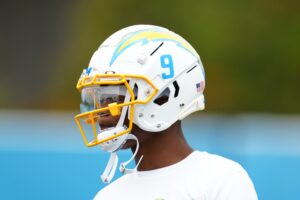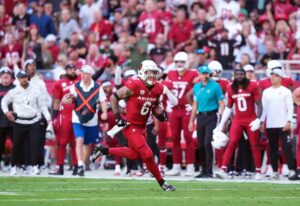Overview
Position: Cornerback/Safety
Height: 5’11”
Weight: 206 pounds
School: Iowa Hawkeyes
Combine Performance Data
Bench press: 14 reps
Vertical jump: 34 inches
Broad jump: 9 feet, 9 inches
Desmond King 2017 NFL Draft Profile
Desmond King is coming off a stellar career while at the University of Iowa. During King’s career as a Hawkeye, he registered 14 interceptions. Besides being the Hawkeyes top cover corner his last two seasons, he also was their primary kickoff and punt returner. In his final two seasons, King averaged 26.0 yards a kickoff return and 11.2 yards per punt return.
King wasn’t just an athlete playing the cornerback position. He became one of, if not, the top cover cornerback in the Big Ten. King’s best season in college was as a junior. That season, King registered eight interceptions, returning one for a touchdown. He also registered 46 solo tackles in that season. His production was enough to win the Jim Thorpe Award in 2015, given out to the nation’s top defensive back.
However, even with his standout junior campaign, King saw his numbers drop his senior season. King’s interception total dropped to three, but with opposing offenses avoiding to throw to his side of the field, that number wasn’t too bad an output.
King might have been one of the best cover corners in the Big Ten, but that doesn’t guarantee it will translate to the next level. In fact, Daniel Parlegreco of DTPDraftScout believes that King’s skills better translates to a safety at the next level. Parlegreco feels that because of his lack of speed and fluidity in man-to-man coverage, his ball hawking skills would be best used at the safety position. Still, if an NFL team utilizes “cover 2” or zone defenses, King still could be able to play cornerback at the next level.
Strengths
- Above average ball hawking ability;
- Playmaking ability once he makes an interception, always has the chance to take back an interception for a touchdown;
- Proven return ability, on punts and kickoffs;
- Has solid size as a cornerback or even as a safety if he switches positions at the next level.
Weaknesses
- Doesn’t possess the speed to keep up with wide receivers with top end speed;
- Was more productive his junior season than his senior season;
- Questions about his ability to cover in man-to-man coverage, would have to play in a zone or “cover 2” defense;
- If he is moved to safety, he will need time to not only adjust to the NFL but to a new position as well.
NFL Comparison: Former standout Green Bay Packers safety Leroy Butler, another converted college cornerback who thrived at the safety position in the NFL.
Teams with Need at Position: Los Angeles Rams, Tennessee Titans, Buffalo Bills, and Green Bay Packers
Projection: second round
Questions persist about King’s speed, but he had a decent showing at this year’s Senior Bowl. There is still a strong chance that King will end up playing cornerback, but he will need to be in the right system. One team to keep an eye on for King’s talents is the Buffalo Bills. Their new defensive coordinator, Leslie Frazier, is a Tony Dungy disciple and loves to run the cover 2. He could be a solid fit for Frazier’s defense.
If King does make the switch to safety, he has the chance to become what Leroy Butler was in his career. Butler, who was a cornerback at Florida State, was converted to safety with the Green Bay Packers in the 1990s and thrived at the safety position. King has better ball skills than Butler coming out of college, but he will need to become tougher if he is going to be half the player Butler was. King might not be a cornerback at the next level, but there is no reason to believe that won’t be a playmaker like he was at Iowa in the NFL.






